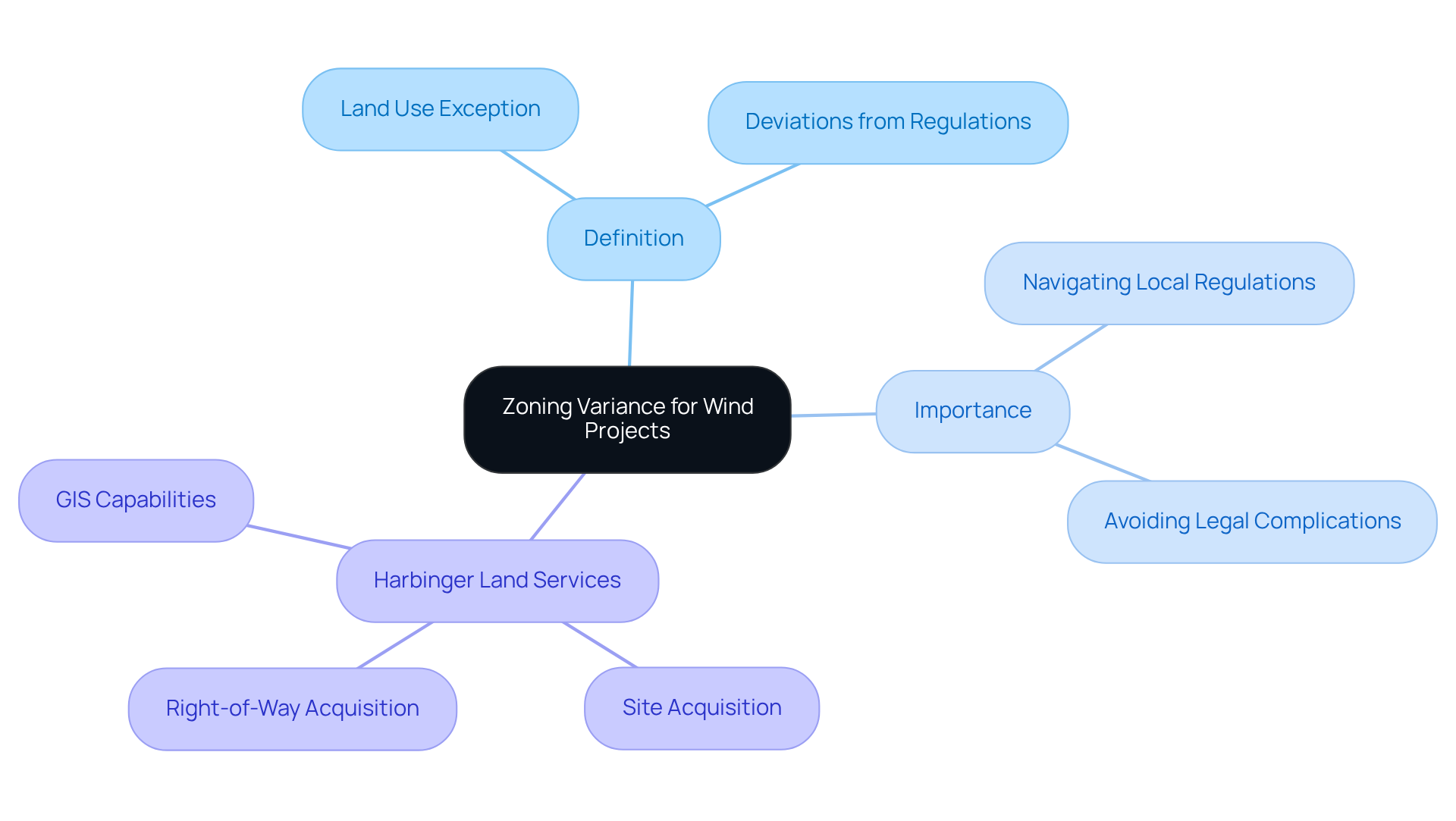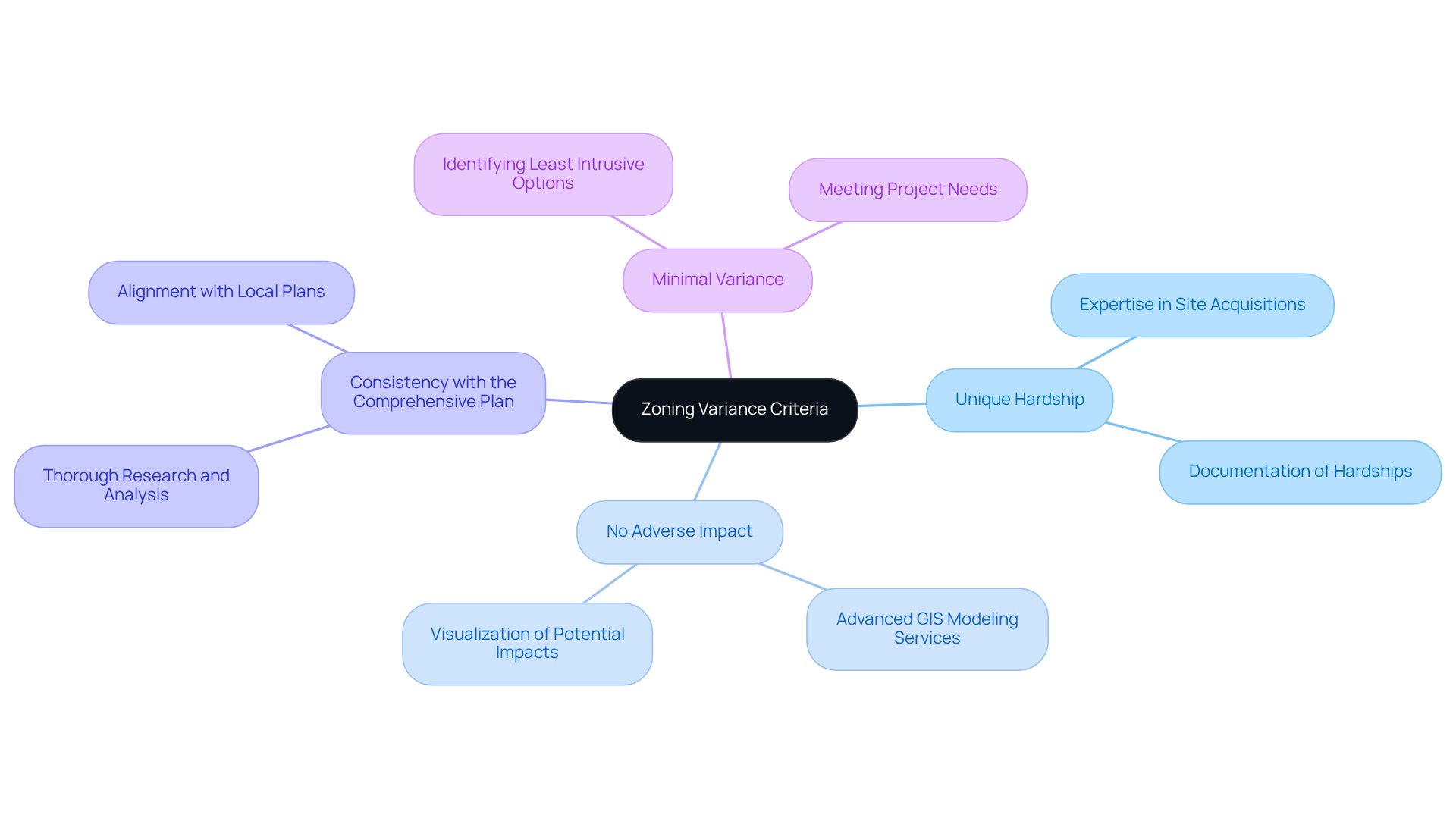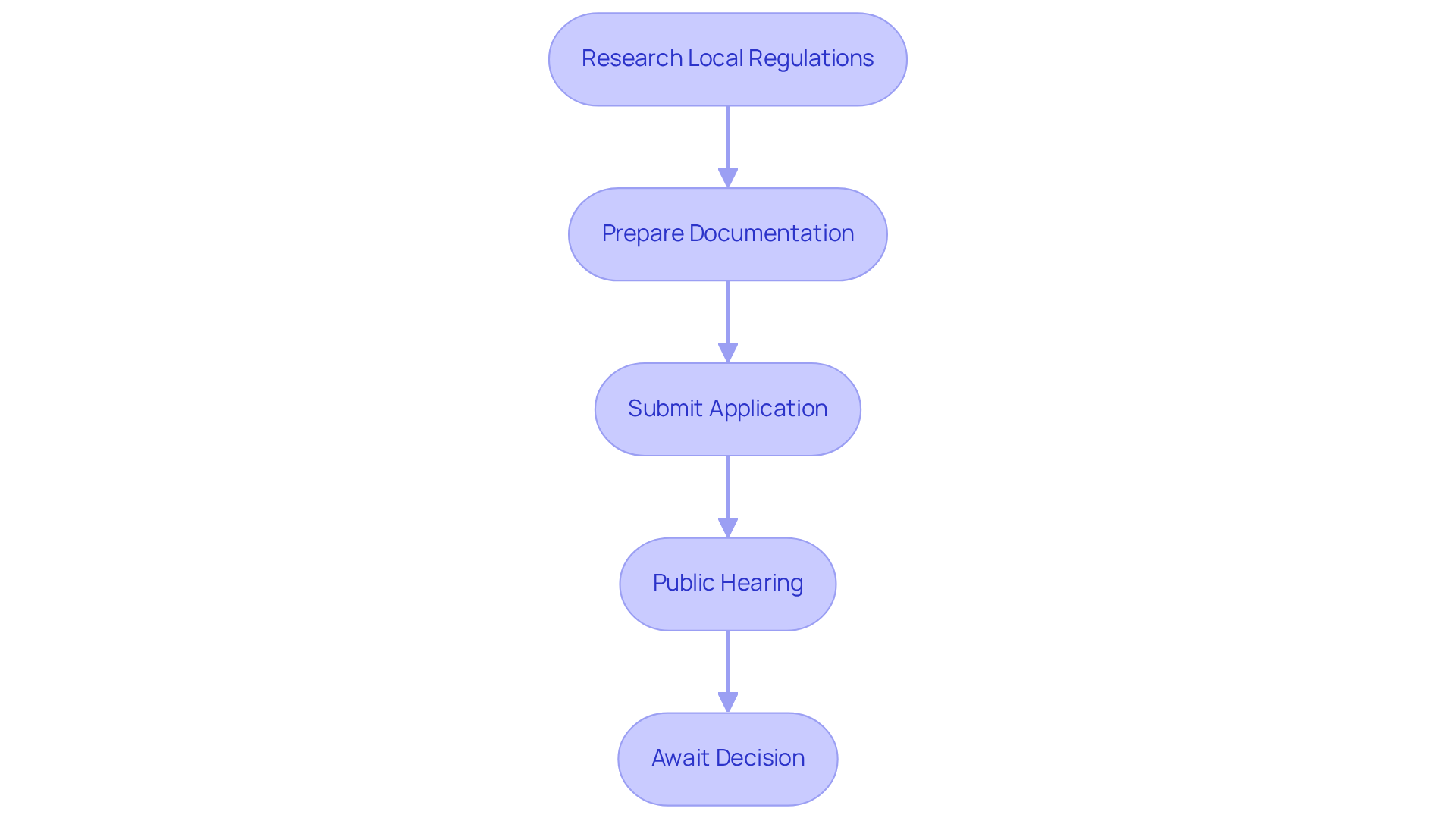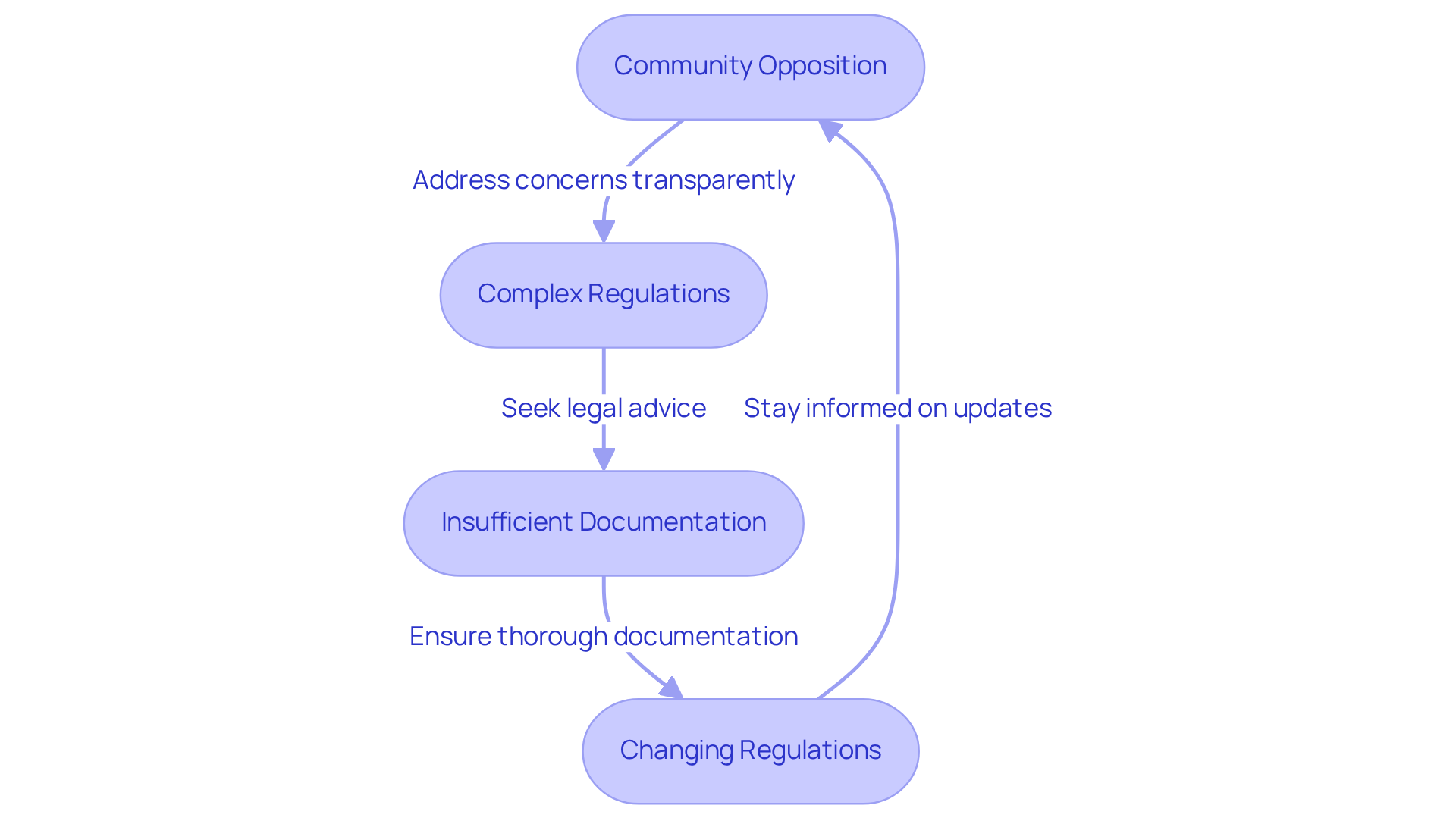Overview
Zoning variances for wind projects are crucial, enabling developers to navigate specific land use regulations that may hinder the installation of wind turbines, such as height and setback limitations. Understanding these variances is essential for overcoming the legal and regulatory challenges associated with land acquisition. Developers must demonstrate unique hardships and ensure that their projects do not adversely impact the community.
Furthermore, adherence to local comprehensive plans is imperative. The complexities involved in navigating these regulatory frameworks for renewable energy initiatives cannot be understated. By grasping these intricacies, stakeholders can effectively advance their projects while contributing to sustainable energy solutions.
Introduction
Navigating the complex landscape of zoning regulations is essential for the successful implementation of wind energy projects. Securing a zoning variance can mean the difference between progress and stagnation. This article explores the critical steps and challenges in obtaining these variances, offering developers valuable insights into the criteria for approval and the intricacies of the application process.
What happens, however, when community opposition and shifting regulations threaten to derail these renewable energy initiatives? Understanding how to effectively address these hurdles is vital for ensuring the growth and sustainability of wind energy.
Define Zoning Variance and Its Importance for Wind Projects
A land use exception represents a critical deviation from existing regulations, as granted by municipal authorities. This exception allows property owners to utilize their land in ways that diverge from standard rules. For wind initiatives, a zoning variance for wind projects is often essential to secure due to specific stipulations that may hinder the installation of wind turbines—such as height limitations or setback criteria from property boundaries. Understanding land use exceptions is vital; they empower developers to navigate local regulations effectively, ensuring that zoning variance for wind projects is obtained to avoid unnecessary delays or legal complications. This flexibility is crucial for the successful implementation of renewable energy projects and obtaining zoning variance for wind projects, particularly in areas with stringent land use regulations.
Harbinger Land stands ready to assist clients in obtaining the necessary land use modifications through its comprehensive land services, which include site and right-of-way acquisition, complemented by advanced GIS capabilities. By harnessing AI-powered title research, Harbinger Land streamlines the process, alleviating potential challenges. This approach not only simplifies land acquisition but also enhances the overall efficiency of renewable energy project development. In a landscape where regulatory hurdles can pose significant obstacles, partnering with Harbinger Land ensures that clients can focus on their core objectives while we handle the complexities of land use exceptions.

Identify Criteria for Obtaining a Zoning Variance
Securing a zoning variance for wind projects poses significant challenges for applicants. To navigate these complexities, it is essential to demonstrate several key criteria:
- Unique Hardship: Applicants must illustrate that the strict application of the zoning ordinance results in a unique hardship that is not self-imposed. Harbinger Land's expertise in site and right-of-way acquisitions can effectively identify and document these unique hardships.
- No Adverse Impact: The proposed modification must not adversely affect neighboring properties or the community. Our advanced GIS modeling services visualize potential impacts, ensuring that the request for deviation is robustly supported by data.
- Consistency with the Comprehensive Plan: The variance should align with local comprehensive plans and zoning objectives. Harbinger Land offers insights into how the proposed initiative corresponds with these plans through thorough research and analysis.
- Minimal Variance: The request should be the minimum necessary to alleviate the hardship. Our team assists in identifying the least intrusive options that still meet project needs.
Understanding these criteria is crucial for applicants to construct a persuasive argument for their request for a zoning variance for wind projects, thereby enhancing the likelihood of approval. By leveraging Harbinger Land's expertise in site and right-of-way acquisitions along with advanced GIS modeling services, applicants can streamline the process of obtaining necessary easements and leases. This combined approach not only conserves time and resources but also enhances decision-making, ensuring adherence to regulatory standards while supporting the development of renewable energy infrastructure.

Outline the Application Process for Zoning Variance
Acquiring a zoning variance for wind projects involves several critical steps:
-
Research Local Regulations: Begin by thoroughly understanding local land-use laws and the specific requirements for modification requests. This foundational knowledge is crucial for effectively navigating the process. As Sarah Lee notes, "By understanding and effectively utilizing zoning adjustment regulations, you establish the foundation for more innovative and community-responsive urban development."
-
Prepare Documentation: Gather all necessary documents, including detailed site plans, the application form for exceptions, and supporting materials that clearly articulate the need for the exception. Effective documentation is vital for demonstrating compliance with regional requirements. The significance of meticulous documentation cannot be overstated, as it greatly enhances the likelihood of success in obtaining a zoning variance for wind projects.
-
Submit Application: File the completed application with the local planning board or department, ensuring that all required fees are paid. A well-prepared application can substantially influence the board's perception.
-
Public Hearing: Attend the public hearing where the zoning board reviews the application. Be prepared to present your case compellingly and address any questions or concerns raised by board members and the public. Engaging with the community can cultivate support for your application. Public notification is essential, allowing neighboring property owners to express their opinions during the hearing.
-
Await Decision: After the hearing, the board will deliberate and issue a decision. If the exemption is granted, it is crucial to comply with any conditions set by the board. The approval process typically spans several weeks to several months, so patience is paramount.
By carefully following these steps, you can significantly improve your chances of a successful application for a zoning variance for wind projects. For example, in the case of "Obtaining a Zoning Variance in Georgia," property owners effectively navigated the multi-step process by adhering to these guidelines.

Address Challenges in Securing Zoning Variances
Securing a zoning variance for wind projects presents several significant challenges that require careful navigation:
-
Community Opposition: Local residents frequently voice concerns about noise, aesthetics, and potential impacts on property values. Early engagement with the community is essential; addressing these concerns transparently can significantly mitigate opposition. Proactive outreach efforts that provide clear information about the project can positively influence public perception and foster support, as highlighted by experts in the field.
-
Complex Regulations: The intricate framework of regional planning laws can be overwhelming. Developers are strongly encouraged to seek advice from legal specialists or land use professionals who can provide clarity and direction, ensuring adherence to the numerous regulations at state and federal levels. Understanding local zoning compliance is crucial for effectively navigating these complexities, particularly with the involvement of key regulatory bodies such as the Federal Energy Regulatory Commission (FERC) and local planning commissions.
-
Insufficient Documentation: A compelling case supported by thorough records is vital for obtaining an exception. Inadequate or poorly prepared materials can lead to denial. Developers must ensure that all required documentation is comprehensive and well-organized, demonstrating adherence to regulatory standards and community concerns. Meticulous documentation of compliance activities is essential to support the permitting process.
-
Changing Regulations: Zoning laws can be altered, influencing the adjustment process. Staying informed about local regulatory updates is crucial for timely applications. Engaging qualified environmental consultants can help ensure compliance with evolving regulations, including NEPA and state requirements. States like Texas, Oklahoma, Iowa, Kansas, and Illinois have successfully navigated these regulatory frameworks, providing valuable examples for developers.
By understanding these challenges and proactively addressing them, applicants can significantly enhance their chances of successfully securing the necessary zoning variance for wind projects. This proactive approach ultimately contributes to the growth of renewable energy initiatives.

Conclusion
Navigating the zoning variance process is essential for the successful implementation of wind projects. This critical land use exception enables developers to surmount regulatory hurdles that could otherwise obstruct the installation of vital infrastructure. Recognizing the importance of zoning variances not only empowers project developers but also significantly advances renewable energy initiatives, ensuring that projects can move forward without unnecessary delays.
This article outlines key criteria for obtaining a zoning variance, including:
- Demonstration of unique hardship
- Assurance of no adverse impact on the community
- Alignment with local comprehensive plans
The application process is detailed, highlighting the necessity of thorough research, meticulous documentation, and active community engagement. Effectively addressing challenges such as community opposition and complex regulations is crucial for enhancing the likelihood of approval.
The significance of securing zoning variances transcends individual projects; it contributes to the broader objective of expanding renewable energy infrastructure. Developers are encouraged to leverage available resources and expertise to navigate this intricate landscape effectively. By doing so, they not only promote sustainable energy solutions but also foster community support and compliance with evolving regulations, paving the way for a greener future.
Frequently Asked Questions
What is a zoning variance?
A zoning variance is a land use exception granted by municipal authorities that allows property owners to use their land in ways that deviate from existing regulations.
Why is a zoning variance important for wind projects?
A zoning variance is important for wind projects because it helps overcome specific regulations, such as height limitations or setback criteria, that may hinder the installation of wind turbines.
How does understanding land use exceptions benefit developers?
Understanding land use exceptions empowers developers to navigate local regulations effectively, ensuring that they can obtain necessary zoning variances and avoid delays or legal complications.
What role does Harbinger Land play in obtaining zoning variances?
Harbinger Land assists clients in obtaining necessary land use modifications through comprehensive land services, including site and right-of-way acquisition and advanced GIS capabilities.
How does Harbinger Land enhance the efficiency of renewable energy project development?
Harbinger Land enhances efficiency by utilizing AI-powered title research to streamline the land acquisition process, alleviating potential challenges and allowing clients to focus on their core objectives.
What challenges do regulatory hurdles pose for renewable energy projects?
Regulatory hurdles can pose significant obstacles for renewable energy projects, making it crucial for developers to secure zoning variances and navigate land use regulations effectively.
List of Sources
- Outline the Application Process for Zoning Variance
- The Ultimate Guide: Zoning Variance Rules & Tips (https://numberanalytics.com/blog/ultimate-guide-zoning-variance)
- The Process of Obtaining a Zoning Variance in Georgia - Chilivis Grubman LLP (https://cglawfirm.com/2024/03/18/the-process-of-obtaining-a-zoning-variance-in-georgia)
- How to Secure a Zoning Variance: A Step-by-Step Guide - HAR.com (https://har.com/ri/1396/a-guide-to-applying-for-a-zoning-variance)
- Zoning Variances: Definition & Techniques | Vaia (https://vaia.com/en-us/explanations/architecture/land-and-property-management/zoning-variances)
- Address Challenges in Securing Zoning Variances
- Understanding Local Zoning Compliance for Wind Farms: An In-Depth Tutorial (https://blog.harbingerland.com/understanding-local-zoning-compliance-for-wind-farms-an-in-depth-tutorial)




